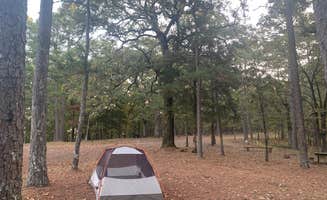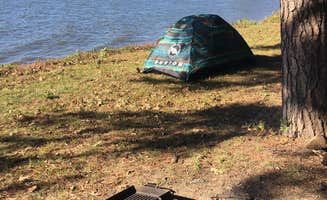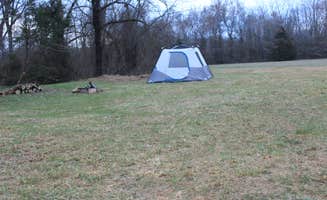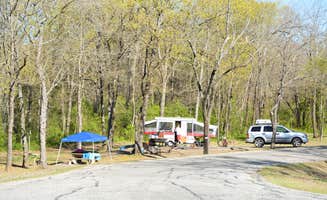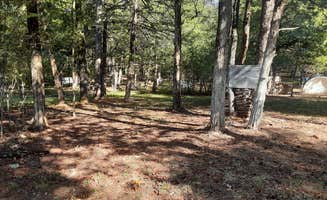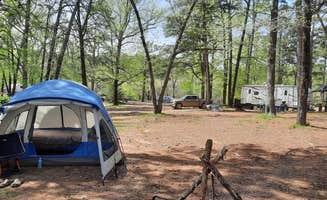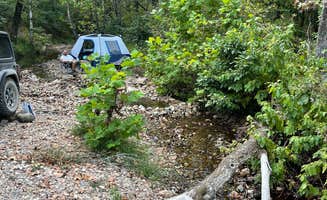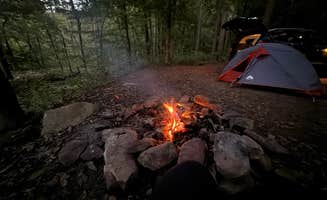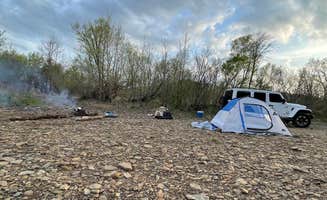The Ozark and Ouachita National Forests surrounding Blue Mountain, Arkansas contain numerous primitive campsites at elevations ranging from 600 to 2,700 feet. This region receives approximately 54 inches of rainfall annually, creating lush forests and seasonal streams. Camping conditions vary significantly between spring and fall, with summer temperatures typically reaching 90°F during daytime hours.
What to do
Waterfall swimming: Haw Creek Falls Camping provides direct water access. "Fun campground, not exactly remote but private enough. Swimming area is fantastic, a much needed relief after a hot day of hiking!" notes Samantha W. The falls area accommodates day visitors and overnight campers.
Mountain biking: Big Brushy connects to several forest service trails. "There are several walking trails down to the creek," explains Mark. Located just off the highway, this small 4-site campground serves as a convenient trailhead for day hikes.
Wildlife viewing: Early morning hours at tent campsites near Blue Mountain, Arkansas offer opportunities to spot deer, small mammals and numerous bird species. At Hickory Nut Mountain, campers report regular sightings, particularly at dawn and dusk when wildlife activity peaks.
What campers like
Ridgetop views: Hickory Nut Mountain offers distant lake vistas. "This campground was located down a 3 mile gravel road, on the top of a ridge overlooking Lake Ouachita. The view of the lake was fairly limited, but the site we stayed in did have a clearing in the trees big enough to catch a glimpse of the lake," reports Emerald B.
Budget-friendly options: Fourche Mountain Campground provides free basic camping. "Small 5-site primitive campground. No water. No electric. Clean vault toilets with tp, and a trash barrel. Clean campground & campsites," states Fred S. Sites include picnic tables and fire rings.
Solitude: Remote tent camping locations near Blue Mountain offer weekday solitude, especially during spring and fall. Many primitive camping areas have minimal facilities but maximum privacy when avoiding summer weekends and holidays.
What you should know
Weather preparedness: Flash floods affect low-lying tent campsites near Blue Mountain, Arkansas, particularly during spring storms. At Big Brushy, "This creek floods quickly and there are signs located through the park indicating it is a flash flood area," warns Mark.
Road conditions: Buzzards Rock Dispersed requires careful driving. "Located in the Mt. Magazine Wildlife Management Area of the Ozark National Forest. The dispersed campsite is on Forest Road 96022B, after the end of Eickleberry Road (FR 1613). There are no obstacles with accessing the site on the forest roads," explains Fred S.
Noise considerations: Some camping areas experience more noise than others. Buzzards Rock's location means "The campsite is surrounded by OHV trails resulting in noise. There was plenty of OHV activity here during our mid-week stay," according to reviews.
Tips for camping with families
Safety first: Most tent campsites near Blue Mountain lack cell service, requiring advance planning. Haw Creek Falls has "No cell service at all!" reports Dawn G., making it essential to bring emergency supplies.
Swimming options: Irons Fork Primitive Camping offers accessible water activities. "Spot #1 was right at the waters edge. Concrete/stone picnic table, grill, firepit. The trees were perfect size and spacing for a hammock. Right next to the boat ramp. Lots of people fishing. Great for kayaking," says Stephanie P.
Bring entertainment: Limited developed facilities mean families should pack their own recreation items. Sites typically provide open areas for games, but no formal playgrounds or organized activities exist at most primitive locations.
Tips from RVers
Size limitations: Jack Creek Recreation Area accommodates smaller rigs. "It's on a loop so it's hard to maneuver into a spot," notes Daisee Mae S. Most primitive campsites around Blue Mountain restrict vehicle size due to narrow access roads.
Leveling challenges: Uneven terrain at many sites requires leveling equipment. At Hickory Nut Mountain, "The spot we picked was mostly rocky and downhill, so not great for tent camping," reports one camper, highlighting the need for stabilizers or leveling blocks.
Seasonal access: Winter and early spring can render some forest roads impassable for larger vehicles. The elevation changes and unpaved access roads may limit RV camping to drier months, with most RVers preferring established campgrounds rather than primitive sites during potentially wet periods.


